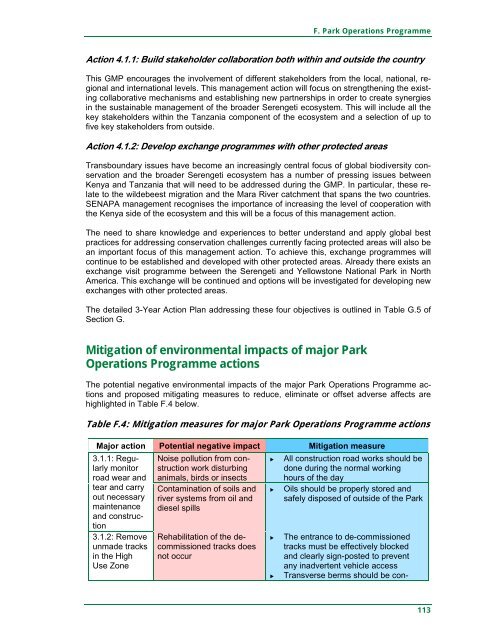Serengeti General Management Plan
Serengeti General Management Plan
Serengeti General Management Plan
- TAGS
- serengeti
- www.zgf.de
You also want an ePaper? Increase the reach of your titles
YUMPU automatically turns print PDFs into web optimized ePapers that Google loves.
F. Park Operations Programme<br />
Action 4.1.1: Build stakeholder collaboration both within and outside the country<br />
This GMP encourages the involvement of different stakeholders from the local, national, regional<br />
and international levels. This management action will focus on strengthening the existing<br />
collaborative mechanisms and establishing new partnerships in order to create synergies<br />
in the sustainable management of the broader <strong>Serengeti</strong> ecosystem. This will include all the<br />
key stakeholders within the Tanzania component of the ecosystem and a selection of up to<br />
five key stakeholders from outside.<br />
Action 4.1.2: Develop exchange programmes with other protected areas<br />
Transboundary issues have become an increasingly central focus of global biodiversity conservation<br />
and the broader <strong>Serengeti</strong> ecosystem has a number of pressing issues between<br />
Kenya and Tanzania that will need to be addressed during the GMP. In particular, these relate<br />
to the wildebeest migration and the Mara River catchment that spans the two countries.<br />
SENAPA management recognises the importance of increasing the level of cooperation with<br />
the Kenya side of the ecosystem and this will be a focus of this management action.<br />
The need to share knowledge and experiences to better understand and apply global best<br />
practices for addressing conservation challenges currently facing protected areas will also be<br />
an important focus of this management action. To achieve this, exchange programmes will<br />
continue to be established and developed with other protected areas. Already there exists an<br />
exchange visit programme between the <strong>Serengeti</strong> and Yellowstone National Park in North<br />
America. This exchange will be continued and options will be investigated for developing new<br />
exchanges with other protected areas.<br />
The detailed 3-Year Action <strong>Plan</strong> addressing these four objectives is outlined in Table G.5 of<br />
Section G.<br />
Mitigation of environmental impacts of major Park<br />
Operations Programme actions<br />
The potential negative environmental impacts of the major Park Operations Programme actions<br />
and proposed mitigating measures to reduce, eliminate or offset adverse affects are<br />
highlighted in Table F.4 below.<br />
Table F.4: Mitigation measures for major Park Operations Programme actions<br />
Major action Potential negative impact Mitigation measure<br />
� All construction road works should be<br />
done during the normal working<br />
3.1.1: Regularly<br />
monitor<br />
road wear and<br />
tear and carry<br />
out necessary<br />
maintenance<br />
and construc-<br />
tion<br />
3.1.2: Remove<br />
unmade tracks<br />
in the High<br />
Use Zone<br />
Noise pollution from construction<br />
work disturbing<br />
animals, birds or insects<br />
Contamination of soils and<br />
river systems from oil and<br />
diesel spills<br />
Rehabilitation of the decommissioned<br />
tracks does<br />
not occur<br />
hours of the day<br />
� Oils should be properly stored and<br />
safely disposed of outside of the Park<br />
� The entrance to de-commissioned<br />
tracks must be effectively blocked<br />
and clearly sign-posted to prevent<br />
any inadvertent vehicle access<br />
� Transverse berms should be con-<br />
113
















